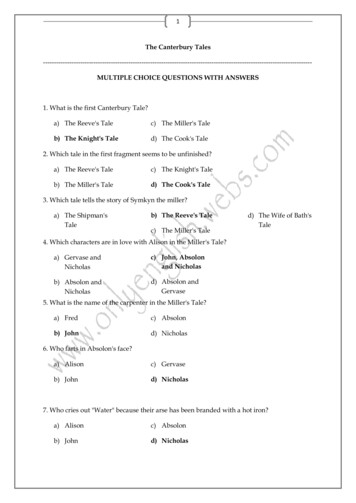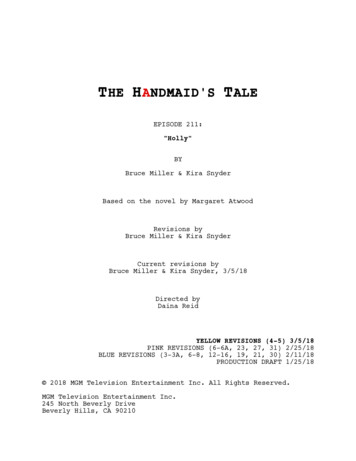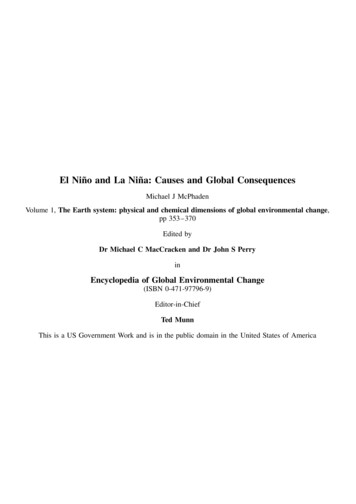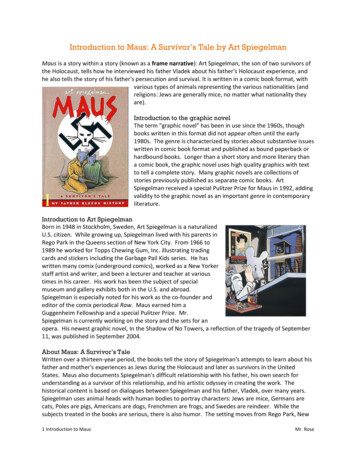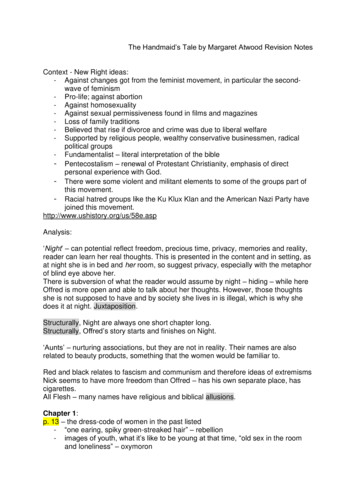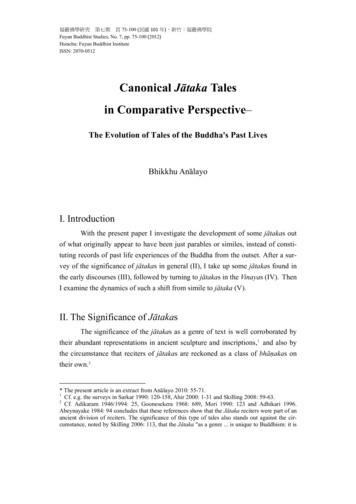
Transcription
A Tale of Two Anomalies: The Implication of InvestorAttention for Price and Earnings Momentum Kewei Hou†, Lin Peng‡ and Wei Xiong§December 19, 2006AbstractWe examine the profitability of price and earnings momentum strategies. We find that price momentum profits are higher among high volumestocks and in up markets, while earnings momentum profits are higheramong low volume stocks and in down markets. In the long run, pricemomentum profits are reversed, while earnings momentum profits are not.The dichotomy between price and earnings momentum is more pronouncedwhen we orthogonalize one with respect to the other. To the extent thattrading volume increases with investor attention and that investors tend topay more attention to stocks in up markets, our results suggest a dual rolefor investor attention: while price underreaction to earnings news declineswith investor attention, price continuation caused by investors’ overreactionrises with attention. We thank Nick Barberis, Michael Brandt, Lauren Cohen, Stefano Della Vigna, David Hirshleifer,Harrison Hong, Mark Seasholes, Tim Simin, and seminar and conference participants at UC Davis,Baruch College CUNY, Ohio State University, CRSP Forum 2006, and the 17th Annual Conferenceon Financial Economics and Accounting for valuable comments and suggestions. We are grateful tothe Institute for Quantitative Research in Finance (Q-Group) for a research grant supporting thisproject. Hou thanks the Dice Center for Research in Financial Economics and the Dean’s SummerResearch Fellowship at the Ohio State University for financial Support. Peng thanks Eugene LangJunior Faculty Research Fellowship and PSC-CUNY Research Award for financial support.†Fisher College of Business, Ohio State University. Email: hou.28@osu.edu.‡Zicklin School of Business, Baruch College. Email: lin peng@baruch.cuny.edu.§Princeton University and NBER. Email: wxiong@princeton.edu.
1IntroductionAttention is a scarce cognitive resource (Kahneman, 1973). A large body of psychological research shows that there exists a limit to the central cognitive-processingcapacity of the human brain.1 The inevitability of limited attention in relation to thevast amount of information available makes attention an important factor in agents’learning and decision-making processes. There is now a growing literature analyzingthe economic consequences of agents’ attention. Sims (2003) models agents’ attentionconstraints to explain consumption and price stickiness. Hirshleifer and Teoh (2003,2005) analyze firms’ accounting disclosure policy and the resulting price dynamics inthe presence of inattentive investors. Gabaix, et al (2005) study agents’ directed attention in response to economic incentives. Barber and Odean (2005) study how salientevents can capture investors’ attention and affect their stock buying and selling decisions. Peng (2005) and Peng and Xiong (2006) analyze the effects of limited attentionon investors’ learning behavior and equilibrium price dynamics.Attention is a crucial factor in investors’ reaction to information. In this paper,we examine how attention affects asset price dynamics through investors’ under- andoverreactions to information, two basic mechanisms developed in the finance literatureto explain a large body of empirical anomalies in asset return predictability.2 Specifically, we analyze the role of investor attention in two widely documented anomalies –price momentum and earnings momentum (also known as post-earnings announcementdrift).We hypothesize that investor attention has a dual role– on the one hand, inadequate attention directly causes ignorance of useful information and therefore stockprice underreaction; on the other, attention can interact with investors’ behavioralbiases, such as extrapolative expectations and overconfidence, to generate price overreaction. When investors pay less attention to a company’s stock, they are more likelyto ignore the company’s earnings announcements and, therefore, they are unable to1See Pashler and Johnston (1998) for a recent review of these studies.See Hirshleifer (2001) and Barberis and Thaler (2003) for recent reviews of these empirical anomalies and the related behavioral theories.21
fully incorporate the information into the stock prices. Consequently, there is a morepronounced post-announcement drift as this information later becomes reflected in theprices. Post-earnings announcement drift has been documented by a large number ofempirical studies, e.g., Ball and Brown (1968) and Bernard and Thomas (1989). Theyfind that buying stocks with recent good earnings news, while simultaneously shortingstocks with recent bad earnings news, can generate positive profits that are unrelatedto risk.Attention is also a necessary condition for investors to overreact to any information.The existing models typically attribute overreaction to behavioral biases. For example, De Long, et al (1990) associate investors’ overreaction to assets’ past returns withtheir extrapolative expectations. Daniel, Hirshleifer and Subrahmanyam (1998) useoverconfidence and self attribution bias as a source of investors’ overreaction to theirprivate information. Both of these overreaction mechanisms can explain price momentum. This is a phenomenon, as documented by Jegadeesh and Titman (1993), whereinbuying stocks with recent superior returns while simultaneously shorting stocks withrecent inferior returns can provide excess profits. While these behavioral biases havereceived considerable thought in the literature, a crucial ingredient in these mechanisms– investor attention – is often ignored. We introduce attention into these mechanismsand hypothesize that overreaction-driven price momentum is more pronounced amongthose stocks that attract more investor attention.In this paper, we perform both cross-sectional and time-series tests of our hypothesisusing proxies associated with investor attention. For the cross-sectional analysis, weuse trading volume as a proxy. Trading often involves investors’ attention in analyzingtheir portfolios and asset fundamentals. On the one hand, when investors pay lessattention to a stock, they are less likely to trade it; on the other, when they paymore attention to a stock, behavioral biases such as overconfidence can give rise toheterogeneous opinions among investors about asset fundamentals, thus generatingmore trading (Odean, 1998 and Scheinkman and Xiong, 2003). In consideration ofboth effects, the hypothesis for the cross-sectional analysis is that low volume stockstend to exhibit stronger price underreaction to earnings news; in contrast, high volume2
stocks tend to display stronger overreaction-driven price momentum.We test this hypothesis by analyzing the profitability of price and earnings momentum strategies for stocks with different levels of trading volume. We constructtwo-way sorted portfolios of NYSE/AMEX stocks using volume and prior stock returns. We measure price momentum profit as the average return difference betweenpast winners and losers. Similarly, we construct portfolios sorted by volume and standardized unexpected earnings (SUE). We measure earnings momentum profits by thereturn difference between stocks having the highest and the lowest unexpected earnings. We also consider the possibility that investors’ under- and overreactions couldoperate together in generating both price and earnings momentum profits. To focus onthe part of price momentum profits caused by investors’ overreaction to past returns,we regress the prior one-year return onto SUE and use the regression residual as thesorting variable to form price momentum portfolios. Likewise, to focus on the part ofearnings momentum profits caused by investors’ underreaction to earnings news, weregress unexpected earnings onto the prior 12-month stock return and use the regression residual as the sorting variable to form earnings momentum portfolios. To accountfor the return premia associated with size and book-to-market equity, we adjust stockreturns by employing the Fama and French (1993) three-factor model at the portfoliolevel and a characteristic-based matching procedure as in Daniel, Grinblatt, Titman,and Wermers (1997) at the individual stock level.We find that price momentum profits, in both raw and adjusted returns, monotonically increase with trading volume. The difference in characteristic-adjusted pricemomentum profits between the highest and lowest volume quintiles is both statisticallyand economically significant with a value of 83 basis points per month. Controllingfor earnings momentum causes the price momentum profits to drop across volumequintiles, but does not change the monotonically increasing relationship between pricemomentum profits and volume. We also find evidence of reversal – the long-run returns of the price momentum portfolios for months 13-60 after portfolio formation arenegative for all volume quintiles with or without controlling for earnings momentum.Overall, these results suggest that there is a significant overreaction-driven component3
in price momentum and this component monotonically increases with trading volume,consistent with our hypothesis that over-reaction driven price momentum increaseswith investor attention.We find that earnings momentum profits decrease with trading volume, with adifference in characteristic-adjusted profits between the two extreme volume quintilesof 64 basis points per month. The difference becomes even larger after controlling forprice momentum. The characteristic-adjusted profit in the lowest volume quintile is94 basis points per month higher than that in the highest quintile, and this differenceis significant with a p-value of 0.01%. Controlling for price momentum also causes asizable drop in earnings momentum profits among high volume stocks, suggesting thatearnings momentum profits are partially related to price momentum. Finally, the longrun returns of the earnings momentum portfolios in years 2-5 show no sign of reversal.These results support our hypothesis that investors’ underreaction to earnings newscontributes to earnings momentum and the degree of underreaction is decreasing withinvestor attention.We also analyze the time-series implications of investor attention for price and earnings momentum. A recent study by Karlsson, Loewenstein and Seppi (2005) documentsan “ostrich effect”– investors pay more attention to stocks in rising markets, but “puttheir heads in the sand” in flat or falling markets. The ostrich effect motivates us tohypothesize that investors’ underreaction to earnings news is stronger in down markets than in up markets, but overreaction-driven price momentum is weaker in downmarkets.We define a month as an “UP” or “DOWN” market depending on whether themarket return for the prior 36 or 24 months is above or below zero. We then analyze the patterns in price and earnings momentum profits across the UP and DOWNmonths. We find that price momentum profits barely exist in DOWN months, but aresignificantly positive in UP months. The difference, more than 1 percent per month, isstatistically significant. By contrast, the earnings momentum profits, after controllingfor price momentum, are significantly higher in DOWN months than in UP monthswith a difference of 42 basis points per month. We also employ an alternative defini4
tion of market states based on the business cycles classified by the National Bureau ofEconomic Research (NBER) and find similar results. The opposing patterns in priceand earnings momentum profits across UP and DOWN months directly support ourattention-based hypothesis.Our study contributes to the literature on price and earnings momentum anomaliesby demonstrating that the analysis of investor attention can sharpen our understandingof the two phenomena. Existing theories in behavioral finance adopt mechanismsbased on either investors’ under- or overreaction to explain these two phenomena.Although there is evidence supporting both types of mechanisms, the literature remainslargely inconclusive on which mechanism is the main driver. This is because competingtheories often make similar predictions regarding each phenomenon, lacking distinctimplications to differentiate their sources. Incorporating investor attention allows us togenerate contrasting predictions for under- and overreaction-based mechanisms, whichwe test empirically.Our study also contributes to the growing empirical literature analyzing the effectsof investor inattention on stock price dynamics, e.g., Huberman and Regev (2001), Hirshleifer, et al (2004), Hou and Moskowitz (2005), Hong, Torous and Valkanov (2005),Della Vigna and Pollet (2005a, b), Cohen and Frazzini (2006), and Hirshleifer, Lim andTeoh (2006). These studies provide evidence that stock prices underreact to public information about firm fundamentals, such as new products, earnings news, demographicinformation, or information about related firms. Our results emphasize the dual roleof investor attention: investor attention not only affects stock price underreaction, butalso interacts with price overreaction. This dual role sharpens our understanding ofearnings and price momentum, two pervasive patterns in stock price dynamics.Finally, our study adds to the findings of Lee and Swaminathan (2000) and Cooper,Gutierrez, and Hameed (2004). Lee and Swaminathan find that price momentum ismore pronounced among high volume stocks, while Cooper, Gutierrez, and Hameedshow that price momentum is stronger in up markets. Motivated by the attentionbased hypothesis, we extend these studies by analyzing the joint properties of priceand earnings momentum for stocks with different levels of trading volume and across5
up and down markets.The paper is organized as follows. Section 2 reviews the related empirical andtheoretical literature on price and earnings momentum. Section 3 develops attentionbased hypotheses for these two anomalies. Section 4 describes the data used in ourempirical analysis. In Sections 5, we test our cross-sectional hypothesis using tradingvolume as a proxy of investor attention. In Section 6, we analyze the price and earningsmomentum profits across up and down markets. We conclude in Section 7.2Related literature on price and earnings momentumThere is a large body of literature studying the price and earnings momentum anomalies. In this section, we review several closely related empirical studies and explanationsbased on investors’ under- and overreactions to information.Jegadeesh and Titman (1993) demonstrate that a trading strategy based on buyingrecent winners over the past 3-12 months and simultaneously shorting recent losers cangenerate a significant profit. Fama and French (1996) and Grundy and Martin (2001)show that the Fama-French three-factor model cannot explain this price momentumeffect. Price momentum strategies are not only profitable in the U.S., but also in otherdeveloped and emerging markets, as shown by Rouwenhorst (1998), Griffin, Ji, andMartin (2003), and Hou, Karolyi, and Kho (2006).Several studies, e.g., Ball and Brown (1968) and Bernard and Thomas (1989) findthat for a period of 60 days after earnings announcements, returns of NYSE/AMEXstocks continue to drift up for “good news” firms and down for “bad news” firms.This phenomenon is often referred to as post-earnings announcement drift or earningsmomentum. Chan, Jegadeesh and Lakonishok (1996) show that earnings momentumstrategies are profitable even among larger stocks and cannot be explained by the FamaFrench three-factor model. Furthermore, they show that although price and earningsmomentum are related, one effect cannot be subsumed by the other.Since there is not enough evidence to justify rational factor risk models as the soleexplanation of price and earnings momentum effects, the finance literature has explored6
frictions and biases in investors’ information processing for alternative explanations.Several papers model investors’ underreaction to information, e.g., Barberis, Shleiferand Vishny (1998) and Hong and Stein (1999). In these models, investors underreactto news about firm fundamentals, resulting in insufficient initial price reaction to thenews. As the news gradually gets incorporated into prices, this process generatesboth price and earnings momentum. These models differ in the specific mechanismthat leads to investor underreaction. Barberis, Shleifer and Vishny (1998) assume thatinvestors are subject to conservatism, the tendency to underweight new information andoverweight their priors. Hong and Stein (1999) assume that private information diffusesslowly among a population of “newswatchers”, who makes forecasts based only on theirprivate information. More recently, Hirshleifer and Teoh (2005), Peng (2005), andPeng and Xiong (2006) show that investor inattention can lead to ignorance of usefulinformation and therefore price underreaction. This inattention-based underreactionreflects investors’ attention constraints in information processing, it is not a behavioralbias in itself. Inattention is also a potential explanation for the slow-informationdiffusion mechanism proposed by Hong and Stein (1999). Our hypotheses build on theinattention-based underreaction mechanism.De Long et al (1990) and Daniel, Hirshleifer and Subrahmanyam (1998) focus on investors’ overreactions. De Long et al model positive feedback traders, who buy more ofan asset that has recently gone up in value. This type of positive feedback trading canbe driven by extrapolative expectations, where investors extrapolate past returns intotheir expectation of future returns (a form of overreaction). If a company’s stock pricegoes up this period, positive feedback traders buy the stock in the following period,causing a further price increase, which in turn can generate both earnings and pricemomentum. Daniel, Hirshleifer and Subrahmanyam focus on investors’ overconfidence,a tendency to overestimate the precision of their private information, and self attribution bias, a tendency to attribute success to themselves but failure to external reasons.They show that overconfidence causes investors to overreact to their private information. Self attribution bias causes investors’ confidence level to go up further after publicnews confirms their private information, but to remain unchanged after disconfirming7
public news. This asymmetric response implies that initial overconfidence is, on average, followed by even greater overconfidence. This mechanism generates momentum.We extend these overreaction-driven mechanisms by analyzing their interaction withinvestor attention.Investors’ under- and overreaction to information can work together or independently to generate earnings and price momentum. Both explanations command somesupport from the data. Hong, Lim and Stein (2000) find that price momentum ismore pronounced among smaller firms and firms with lower levels of analyst coverage. Since information tends to diffuse slowly for these firms, their findings supportthe slow information diffusion hypothesis as a potential explanation of price momentum. Lee and Swaminathan (2000) and Cooper, Gutierrez, and Hameed (2004) showthat price momentum profits tend to reverse after two years, suggesting that at leastpart of the observed price momentum profits is driven by investors’ overreaction. Theexisting studies do not find any evidence of long run reversion in earnings momentum (Chan, Jegadeesh and Lakonishok, 1996), suggesting that earnings momentum islargely driven by investors’ underreaction. Our attention-based hypotheses relate toboth investor under- and overreactions by drawing contrasting predictions for price andearnings momentum.3Hypothesis developmentDue to limited attention, investors can only attend to a subset of all available information. Investor attention could have a dual role on stock prices. On the onehand, inadequate attention directly leads to ignorance of certain information and consequently stock price underreaction; on the other, investors’ behavioral biases, suchas extrapolative expectations and overconfidence, could lead to price overreaction toinformation to which investors attend. In this section, we develop this notion and formempirical hypotheses for price and earnings momentum.Investor attention affects asset prices when the marginal investor is attention constrained. This view is supported by the growing evidence that useful public information8
is ignored or only gradually incorporated in stock prices. Huberman and Regev (2001)provide a vivid example: the initial news about a new cancer curing drug from EntreMed was ignored by investors and did not cause much stock price reaction; but whenthe same news appeared several months later on the front page of New York Times,the price jumped up for more than 300%. Hou and Moskowitz (2005) demonstratedelays in the incorporation of information into the prices of individual stocks, especially for smaller and less visible stocks. Hong, Torous, and Valkanov (2005) find thatthe returns of several industry portfolios are able to predict the movement of marketindices in U.S. and eight other developed countries. Della Vigna and Pollet (2005a)show that publicly available demographic information is not fully incorporated intothe stock prices of age-sensitive industries, such as toys, vehicles, beer, life insurance,and nursing homes. Cohen and Frazzini (2006) find that stock prices do not promptlyincorporate public news about economically related firms, such as customers and suppliers. The recent accounting literature, e.g., Sloan (1996) and Hirshleifer, et al (2004),find that a firm’ accruals, a component in reported earnings that adjusts cash flows,have negative predictive power for stock returns, suggesting that investors ignore thedifferences in different earnings components. Della Vigna and Pollet (2005b) find thatearnings announcements made on Friday, during which market participants are usually less attentive to business activities, generate significantly lower price reactions andtrading volume than non-Friday announcements and experience 60 percent greater delayed responses in the long run. Hirshleifer, Lim and Teoh (2006) study the competitionfor investor attention of earnings announcements. They find that the immediate stockprice and volume reaction to a firm’s earnings surprise is weaker, and post-earningsannouncement drift is stronger, when a greater number of earnings announcements byother firms are made on the same day.The marginal investor represents an aggregation of individual and institutional investors in the market. There is evidence suggesting that both individual investors andprofessionals have limited attention.3 Barber and Odean (2005) find that individual in3Many standard asset pricing theories require the existence of perfectly efficient arbitrageurs, whodistill new information with lightning speed and seamless precision. However, such efficiency is unreal-9
vestors’ stock buying and selling decisions are influenced by salient, attention-grabbingevents. Corwin and Coughenour (2005) show that NYSE specialists’ attention constraints affect execution quality (price improvement and transaction cost) in securitiesthat they are responsible for making markets. In addition, Hirst and Hopkins (1998)provide experimental evidence that professional analysts often fail to recall and respondappropriately to information in complex financial disclosures.Limited attention imposes a constraint on the amount of information that investorscan process and react to. Consequently, investors could ignore useful public information. Hirshleifer and Teoh (2005), Peng (2005), and Peng and Xiong (2006) developtheoretical models to analyze this effect. Hirshleifer and Teoh analyze a setting inwhich only a fraction of investors attend to a firm, while Peng and Xiong study modelsin which the marginal investor allocates attention across firms. These models suggestthat, when investors’ attention to a firm is inadequate, they may ignore its earningsannouncements, resulting in stock price underreaction to the earnings news. After theannouncements, the price continues to drift in the direction of the earnings surprises,as the information eventually gets incorporated. Thus, investor inattention gives riseto earnings momentum. Furthermore, the magnitude of the earnings momentum decreases with the level of investor attention.Limited attention is not a behavioral bias, but it could interact with biases inthe way investors react to information. Extrapolative expectations and overconfidenceare two types of behavioral biases that have been used to explain price momentumbased on investor overreaction, e.g., De Long, et al (1990) and Daniel, Hirshleifer andSubrahmanyam (1998). In particular, extrapolative expectations cause investors tooverly extrapolate stocks’ past returns into their expectations of future returns, whileoverconfidence causes investors to overweight their private information and thereforeoverreact to this information. Both mechanisms can generate price momentum, withinvestor attention being a necessary ingredient. If investors do not pay attention toa stock, they can neither overly extrapolate the stock’s past returns, nor overreactistic. In addition, as argued by Shleifer and Vishny (1997) and others, short-term price risk and agencyproblems between professional arbitrageurs and their investors could further limit the effectiveness ofarbitrageurs.10
to their private information. Consequently, there will be no overreaction-driven pricemomentum. Conversely, when investors pay more attention to a stock, these biasescan generate stronger price momentum.In summary, investor attention has a dual role in stock price under- and overreaction: while inadequate attention directly generates price underreaction to earningsnews and earnings momentum, the interaction between attention and investors’ learning biases (extrapolative expectations or overconfidence), leads to overreaction-drivenprice momentum. Cross-sectionally, we expect stocks that receive more investor attention to display stronger overreaction-driven price momentum, but weaker earningsmomentum.It is difficult to directly measure investor attention. The economics and psychologyliterature still do not fully comprehend the determinants of investor attention.4 Weuse trading volume as a proxy of investor attention in our cross-sectional analysis. Onthe one hand, investors cannot actively trade a stock if they do not pay attention to it;on the other, when investors do pay attention, behavioral biases such as overconfidencecan give rise to heterogeneous opinions among investors about asset fundamentals, thusgenerating more trading (Odean, 1998 and Scheinkman and Xiong, 2003).There is evidence supporting the link between trading volume and investor attention. Lo and Wang (2000) show that trading volume tends to be higher among largestocks, consistent with the fact that large stocks attract more investor attention. Chordia and Swaminathan (2000) find that, controlling for firm size, returns of high volumeportfolios lead returns of low volume portfolios, suggesting that low volume stocks receive less investor attention and that trading volume is a better measure of investorattention than firm size. Gervais, Kaniel and Mingelgrin (2001) find that prices ofstocks that experience unusually high volume appreciate more in the following month.4Psychological studies, as reviewed by Yantis (1998), suggest that attention can not only be directedby people’s deliberate strategies and intentions, but also be captured by an abrupt onset of stimulusand other salient events. Economic studies have utilized both channels of directing attention. Sims(2003), Gabaix, et al (2005), Peng (2005), and Peng and Xiong (2006) provide models to analyzeagents’ actively controlled attention in response to economic incentives. In particular, Peng (2005)shows that stocks with greater contribution to the fundamental uncertainty of investors’ portfoliostend to receive more attention allocation. On the other hand, Barber and Odean (2005) examinestock trading generated by investor attention that is driven by salient events.11
They argue that the increase in volume raises a stock’s visibility and attracts moreinvestor attention. Finally, a stock’s abnormal daily trading volume has also been usedby Barber and Odean (2005) as an attention proxy.Using trading volume as a proxy for investor attention, we obtain the followingtestable hypothesis:Hypothesis I. In a cross-section of stocks, those with higher trading volume tend to display stronger price momentum, but weaker earnings momentum.We further expect that the overreaction-driven price momentum would reverse inthe long run, as price overreaction is eventually corrected. In contrast, if earningsmomentum is caused by investor inattention, then the price drift will not reverse inthe long run.The attention that investors allocate to stocks not only varies in the cross-section,but also over time. Karlsson, Loewenstein and Seppi (2005) analyze account activityin three Scandinavian data sets: the daily number of investor account look-ups at alarge Norwegian financial service company, the daily number of online logins of a majorSwedish bank, and the daily number of pension account look-ups by investors of theSwedish Pension Authority. In their study, they find that investors are more likelyto look up their portfolios in up markets than in down markets. This “ostrich effect”suggests that investors pay more attention to stocks in rising markets, but “put theirheads in the sand” in flat or falling markets.5The increased attention in up markets can cause investors to overreact more totheir private information or to past returns, generating a more pronounced pattern ofoverreaction-driven price momentum. The increased attention also means that firms’earnings announ
Attention for Price and Earnings Momentum Kewei Hou†, Lin Peng ‡ and Wei Xiong§ December 19, 2006 Abstract We examine the profitability of price and earnings momentum strate-gies. We find that price momentum profits are higher among high volume stocks and in up markets, while earnings momentum profits are higher

